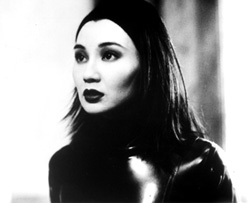FILM NOTES
FILM NOTES INDEX
NYS WRITERS INSTITUTE
HOME PAGE

Irma Vep
(French, 1996, 97 minutes, color, 35 mm)
Directed by Olivier Assayas
Starring:
Maggie Cheung, Jean-Pierre Leaud, Antoine Basler
In French and English with English subtitles
The
following film notes were prepared for the New York State Writers
Institute by Kevin Jack Hagopian, Senior Lecturer in Media Studies
at Pennsylvania State University:
 In the days before World War I, French serials about mysterious, erotic creatures of the night became a fetish of cinema audiences the world over. Nickelodeons from Marseilles to Minneapolis were crowded by those who could hardly bear the wait until the next episode of Louis Feuillade's eerie chapter plays reached the screen. Feuillade's Fantomas featured a lithe, black-clad Parisian stalker, the title character, who was half cat-burglar, half masked avenger. Feuillade's Les Vampyres was equally enigmatic, equally delicious, in its portrayal of exotic danger. The director’s creepy, exciting protagonists have remained close to the hearts of the French ever since. When Olivier Assayas set out to make Irma Vep, he did not forsee that the spirit of Feuillade's mysterians would seem almost to haunt the production.
In the days before World War I, French serials about mysterious, erotic creatures of the night became a fetish of cinema audiences the world over. Nickelodeons from Marseilles to Minneapolis were crowded by those who could hardly bear the wait until the next episode of Louis Feuillade's eerie chapter plays reached the screen. Feuillade's Fantomas featured a lithe, black-clad Parisian stalker, the title character, who was half cat-burglar, half masked avenger. Feuillade's Les Vampyres was equally enigmatic, equally delicious, in its portrayal of exotic danger. The director’s creepy, exciting protagonists have remained close to the hearts of the French ever since. When Olivier Assayas set out to make Irma Vep, he did not forsee that the spirit of Feuillade's mysterians would seem almost to haunt the production.
This is a film like Truffaut's Day For Night, a film ostensibly about a making of a film, but really about the ways in which a shoot draws brings together the compelling "characters" who live inside the actors in the film. Indeed, Jean-Pierre Leaud, Truffaut’s lead in Day For Night, presents a comic version of the great auteurist. We look over the slumping shoulders of a has-been film director who is so beset by personal woes that the film begins to be an inkblot of his own obsessions and fears. Irma Vep is an anagram taken from Les Vampyres, and the Leaud character’s version of the beloved nightmare of 85 years ago is a B-movie, a low-budget bricolage in which the elements of the original are tossed into the air and reassembled rather casually by the distracted director.

The Feuillade serials had been undeniably French, with love and menace in the same cinematic moment. So it dismays everyone associated with the film when "Maggie Cheung," a Hong Kong action star who does not speak French, is pressed into service. (To increase the hall-of-mirrors effect, Maggie Cheung plays "Maggie Cheung" in the film-within-a-film, just as she plays herself in the film about the film-within-the-film.…) The film is to be a modern silent film, but this is less a hip high concept than a way out for the threadbare production company.
What happens on the set combines Fellini with Sam Fuller. We see the tatterdemalion production through Cheung's -- uh, I mean "Cheung's" -- eyes, as everyone on the set takes their lead from "Rene Vidal," the hapless, moderately loony director. It turns out that Maggie's lack of facility with French mimics the problem everyone else on Irma Vep has: none of them seem to be familiar with the lingua Franca of sanity. A dresser romances Maggie, Maggie finds herself at a party where she knows no one, a TV interviewer has a conversation with Maggie in which the interviewer happily ignores Maggie's responses, and finally, Vidal's limited inspiration for the character Maggie is to play seems to be derived from a masturbatory affection for Catwoman.… Maggie is confronted with a bustling internal world of emotions and desires that swirl around her in a pageant at least as frantic as any of the chop-socky epics she had starred in back in Hong Kong. The early returns from the film she's making, however, suggest that the off-screen drama is far more exciting; she fears that the film she's working on will stink up the screen. But when we see Maggie lurking about the hotel in a black latex bodysuit, we realize that she has caught the spirit of the send-up.
Irma Vep, the film we watch, is as entrancing as Feuillade's serials. Its hasty production circumstances -- director Olivier Assayas wrote the script in ten weeks, and the film was shot in a month, with no retakes -- seem perilously close to the ones that cause everyone such grief in the film. But, like those long-ago audiences, we wait breathlessly to see what course these demented but vaguely humane characters will tack off on next. Feuillade's sleek, black-clad protagonists had shrouded their humanity in cloaks and masks. The players in the misguided homage to Les Vampyres wear a much frailer costume. Their unmasking is perhaps not gentle, but it is truly good-spirited.
— Kevin Hagopian, Penn State University
For additional information, contact the Writers Institute at 518-442-5620 or online at https://www.albany.edu/writers-inst.